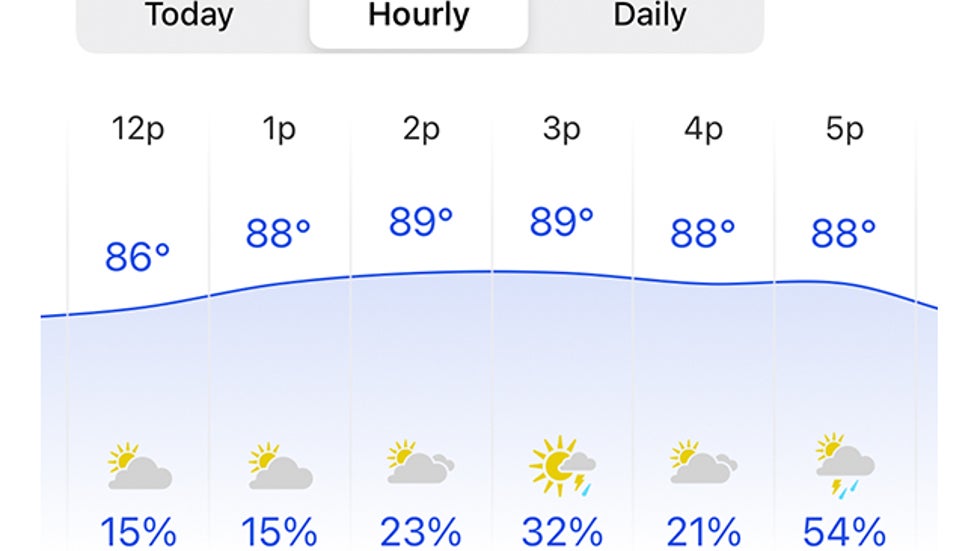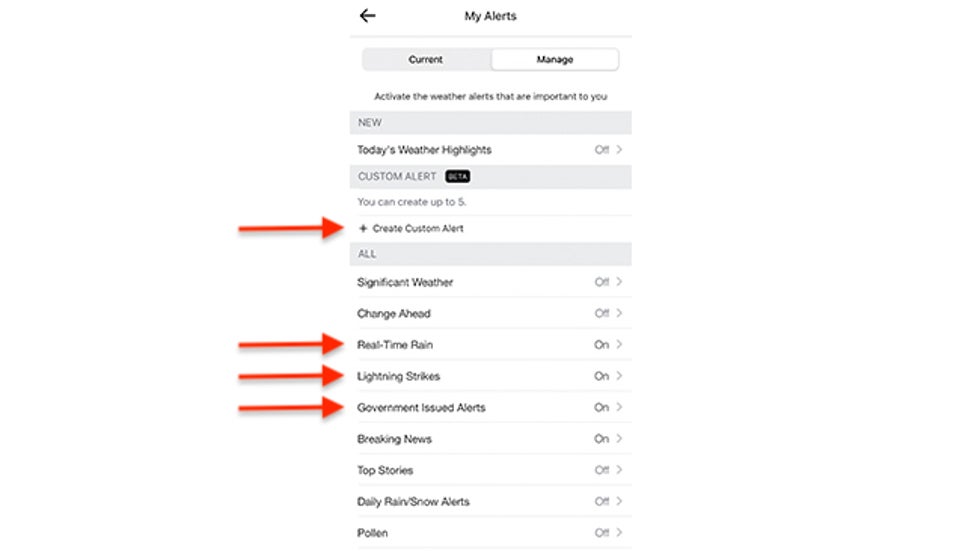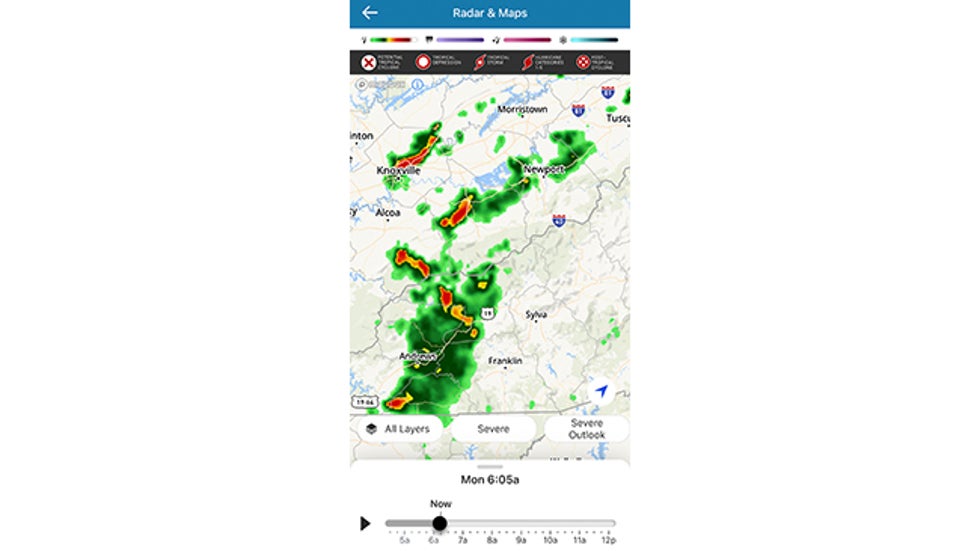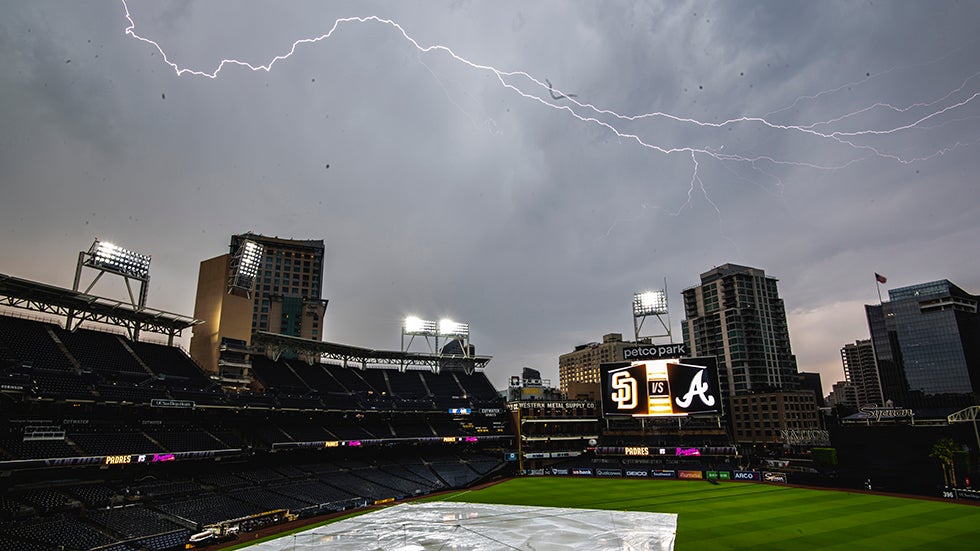Jonathan Erdman
Millions of Americans are looking forward to spending time outdoors in the summer, whether it’s camping, watching fireworks or attending an outdoor concert. But thunderstorms are a reality in much of the country this time of year.
In light of recent events such as the hailstorm at Colorado’s Red Rocks Amphitheatre, we want to remind you that there are things you can do to stay aware and safe the next time you’re enjoying the outdoors.
1. First, check your forecast. If the “chance of thunderstorms” is high, or if severe thunderstorms are forecast for your area, The Weather Channel app will tell you if there is a severe thunderstorm threat right below the current conditions. Consider either canceling your plans or, if possible, moving your plans to another part of the day when the threat is lower.
 An example of an hourly forecast showing the chance of rain from thunderstorms in the afternoon. In this case, if you can move your outdoor plans to earlier in the day, you can avoid the risk of thunderstorms.
An example of an hourly forecast showing the chance of rain from thunderstorms in the afternoon. In this case, if you can move your outdoor plans to earlier in the day, you can avoid the risk of thunderstorms.2. If you have a weather app, turn on alerts. In The Weather Channel app (Apple | Google Play), tap the "bell" icon in the upper right corner, then tap “Manage.” You can turn on alerts for lightning strikes nearby, real-time rain, government issued alerts (watches and warnings from the National Weather Service) or you can create your own custom alert.
 In The Weather Channel app, here's how to turn on alerts for lightning, rain, NWS alerts and how to create your own custom alert.
In The Weather Channel app, here's how to turn on alerts for lightning, rain, NWS alerts and how to create your own custom alert.3. When you arrive at your destination, figure out where you'll go if you need to seek shelter quickly from lightning. That could be a covered concourse at a stadium, another building like a visitor’s center at a park or your vehicle if there are no other buildings around. If severe thunderstorms are possible for your area, you’ll need to get to a substantial building fast when warnings are issued.
4. If you see skies darkening, pull up the radar on your weather app to see if thunderstorms are near. The Weather Channel app has a "play" button on the radar to see how the rain and thunderstorms are moving. It also has a future radar that can show when storms could arrive or develop near you.
 In The Weather Channel app, you can loop radar over the past few hours and also play the latest six-hour forecast by tapping the play button to see if thunderstorms are moving toward your area.
In The Weather Channel app, you can loop radar over the past few hours and also play the latest six-hour forecast by tapping the play button to see if thunderstorms are moving toward your area.5. If you notice thunderstorms on radar are moving your way, see lightning, hear thunder, or receive an alert on your app, move to your shelter immediately. Do not depend on others, including event venue or park staff, to give you an official warning in time. Some cloud-to-ground lightning can travel 10 to 12 miles from a thunderstorm. If you can hear thunder, you're in danger. Also, some thunderstorms can move rapidly, sometimes at speeds of 50 mph or faster, so you might not have as much time to seek shelter as you think.
 Lightning strikes over the ballpark before the San Diego Padres face against the Atlanta Braves on Sept. 24, 2021, at Petco Park in San Diego, California.
Lightning strikes over the ballpark before the San Diego Padres face against the Atlanta Braves on Sept. 24, 2021, at Petco Park in San Diego, California.6. Stay in a shelter until the storms have passed and you no longer hear thunder or see lightning for at least 30 minutes. You can check the radar on your weather app to see if any other storms are approaching while you're in the shelter.
While radar detects thunderstorms and the National Weather Service warns for severe weather, you are ultimately responsible for your safety outdoors when thunderstorms threaten.
You don’t need to be a meteorologist. Using a weather app and your own intuition should keep you safe most of the time.
Jonathan Erdman is a senior meteorologist at weather.com and has been an incurable weather geek since a tornado narrowly missed his childhood home in Wisconsin at age 7. Follow him on Twitter and Facebook.
The Weather Company’s primary journalistic mission is to report on breaking weather news, the environment and the importance of science to our lives. This story does not necessarily represent the position of our parent company, IBM.
The Weather Company’s primary journalistic mission is to report on breaking weather news, the environment and the importance of science to our lives. This story does not necessarily represent the position of our parent company, IBM.

No comments:
Post a Comment